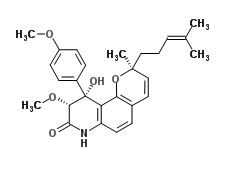Yaequinolone J1
Yaequinolone J1 is a natural product isolated from the endophytic fungus Phomopsis sp., which is found in association with the plant Euchresta horsfieldii. This compound belongs to the class of chemical compounds known as quinolones, which are characterized by a quinoline backbone, a structure comprising a fused ring of benzene and pyridine. Yaequinolone J1 has attracted attention due to its unique structure and potential biological activities, which include antimicrobial and possibly anticancer properties.
Chemistry[edit | edit source]
Yaequinolone J1 is a secondary metabolite with a molecular structure that includes a quinolone core. The compound is notable for its unusual modifications, which differentiate it from other quinolones. These modifications may include various substituents on the quinoline ring, which can significantly affect the compound's biological activity and pharmacokinetic properties.
Biosynthesis[edit | edit source]
The biosynthesis of Yaequinolone J1, like many natural products, involves complex enzymatic pathways. These pathways typically involve the shikimate pathway for the formation of the aromatic system, followed by specific tailoring enzymes that introduce functional groups and structural modifications unique to Yaequinolone J1. The exact biosynthetic steps and enzymes involved in the synthesis of Yaequinolone J1 are subjects of ongoing research.
Biological Activities[edit | edit source]
Yaequinolone J1 has been reported to exhibit antimicrobial activity against a range of pathogenic microorganisms. This includes activity against bacteria and fungi, making it a compound of interest for the development of new antimicrobial agents. Additionally, there is interest in exploring its potential anticancer activities, as many quinolone derivatives have been found to possess cytotoxic properties against various cancer cell lines.
Potential Applications[edit | edit source]
The unique properties of Yaequinolone J1 suggest several potential applications in medicine and pharmacology. Its antimicrobial activity indicates potential use as a lead compound for the development of new antibiotics, particularly in an era of increasing antibiotic resistance. Furthermore, if its anticancer properties are validated, Yaequinolone J1 could contribute to the development of novel anticancer therapies.
Research and Development[edit | edit source]
Research on Yaequinolone J1 is in the early stages, with studies focusing on elucidating its structure, biosynthesis, and biological activities. Future research will likely explore its mechanism of action, optimize its pharmacokinetic properties, and evaluate its efficacy and safety in preclinical and clinical trials.
Conclusion[edit | edit source]
Yaequinolone J1 represents an intriguing subject of study within the field of natural product chemistry and pharmacology. Its potential as a source of new therapeutic agents underscores the importance of exploring and understanding natural products derived from endophytic fungi and other microorganisms.
Navigation: Wellness - Encyclopedia - Health topics - Disease Index - Drugs - World Directory - Gray's Anatomy - Keto diet - Recipes
Search WikiMD
Ad.Tired of being Overweight? Try W8MD's physician weight loss program.
Semaglutide (Ozempic / Wegovy and Tirzepatide (Mounjaro / Zepbound) available.
Advertise on WikiMD
WikiMD is not a substitute for professional medical advice. See full disclaimer.
Credits:Most images are courtesy of Wikimedia commons, and templates Wikipedia, licensed under CC BY SA or similar.Contributors: Prab R. Tumpati, MD

